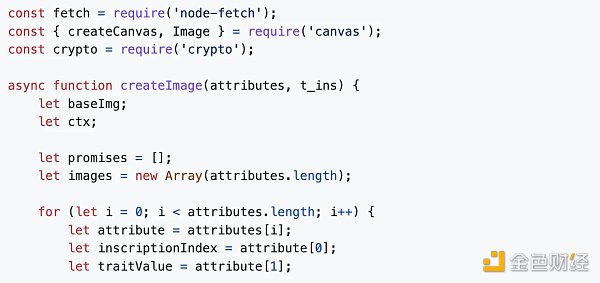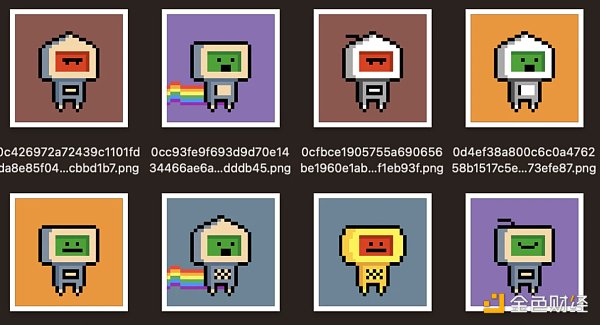First OrdiBots project with a thousand-fold increase? Understand the GBRC721 protocol with this article.
Learn about the GBRC721 protocol and OrdiBot's first project with this article.Author: Wuhai, BlockingNews
On May 30th, according to Dune data, the total number of Bitcoin NFT protocol Ordinals minted inscriptions exceeded 10 million, with a cumulative fee income of 1,578.4611 BTC, worth $44.14 million. Looking back at its short development history, since software engineer Casey Rodarmor officially launched the NFT protocol “Ordinals” on the Bitcoin mainnet on January 30th, the number of inscriptions minted on the Bitcoin chain exceeded one million in early April, and it has grown tenfold in less than two months. The speed of development and the scale of expansion based on the Ordinals protocol are evident.
The direct impact of the increasing number of inscriptions being minted is that the Bitcoin network fees have soared and stabilized at a higher level, and a large number of creators are entering the Bitcoin Ordinals ecosystem, exacerbating the community’s demand for Bitcoin block space. Based on this, developers are constantly launching new protocols or standards to solve or optimize existing pain points. One of the most eye-catching ones in the market is GBRC 721. This article will give you a detailed explanation of the GBRC 721 protocol and its ecological projects.
What is GBRC 721?
The full name of the GBRC 721 protocol is generative-brc-721, and the founder is Jerry (Twitter account @0x Jerry 543), who is also the initiator of the Bitcoin NFT project DogePunks. According to the GBRC 721 protocol document, it can save all on-chain resources, while achieving 50%-90% block space optimization, thus accommodating more creators and promoting innovation. At the same time, it solves the problem that projects have to choose IPFS off-chain storage, making BTC NFTs fully chain-stored. This solution no longer relies on third-party retrieval support.
- Explaining the GBRC721 protocol and its ecosystem projects that have been boosted by OrdiBots’ thousand-fold increase
- What are the backgrounds of these 27 projects that received investments from top crypto VCs in April?
- Listing 5 Catalyst Projects / Narrative: Level Finance, Metavault, Lybra Finance…
As it is adopted by more people and more platforms are connected, the GBRC 721 protocol’s front-end interface displays the actual image generated by the inscriptions minted, rather than textual data. Currently, it can be seamlessly completed by scanning the “gen-brc-721” inscriptions of user text inscriptions. Then, on-chain data can be used to regenerate the image, which is subsequently stored in its system infrastructure, which is similar to the currently popular method.

Deployment and engraving of this protocol is roughly similar to that of BRC20 tokens, including three main operations: 1) use deployment operations to create GBRC721 collections, deployment operations target a JSON/Text engraving, which contains general information about the collection and base 64 encoded data that makes up the collection’s features. Multiple deployment engravings can be created for the same collection, each of which will store a different set of features. 2) Use JSON or text engravings to cast an irreplaceable serial number. 3) Transfer non-fungible Ordinal to standard serial number engravings.
The difference is that because each collection is unique, but cannot be checked for duplicates before the block is confirmed, a collection may be engraved by many people, causing users to spend costs but gain nothing. Based on this, in order to further optimize the community experience and ensure fair distribution, Jerry is considering incorporating an on-chain whitelist. This will require adding an optional new key to the deployment engraving, which will point to a separate engraving containing whitelist details for claiming NFTs. This will provide a more manageable and fair distribution system for collections on GBRC721, preventing unfairness caused by technical reasons, etc.
According to dune data, the GBRC721 ecology currently has more than 10,000 transactions, spending a total of 1.68 BTC, and its ecological projects are also emerging one after another. The following will introduce the most typical projects in its ecology.
OrdiBots
OrdiBots is a case study that Jerry presented to the community when launching the GBRC721 standard, similar to the ordi issued by Domo when launching the BRC20 protocol. OrdiBots is a very “light” collection, making it more efficient to generate more complex special flags combinations.
OrdiBots is a collection of 1,000 cards composed of 26 different features. The total size of 1,000 OrdiBots pictures adds up to about 663 kb, and the network fee when engraving is about 30 sats/vB. The cost of engraving the entire collection is approximately 0.293 BTC (equivalent to approximately USD 7,900). Through the GBRC721 standard, the size of the entire collection is reduced to 294 kb (10 kb + 284 kb), reducing the total block space by about 55%.

OrdiBots was minted on May 22-23 and became the first project under the GBRC 721 innovation standard, receiving enough attention and funding during its early stages. Currently, the total trading volume of Ordinals Wallet and Magiceden is 26.8 BTC, with 65 items listed on Ordinals Wallet and 82 items listed on Magiceden, held by 350 addresses.
At the time of its minting, OrdiBots was priced at around 3 US dollars. With continuous market attention, its floor price rose to a high of 0.12 BTC, currently equivalent to 3200 US dollars, a 1000-fold increase. According to market data from Ordinals Wallet, the highest selling price for its Blocking outfit is 0.175 BTC. The current market value of OrdiBots is 77.7 BTC, equivalent to 2.1 million US dollars. The current market leader for NFT collections based on the Ordinals protocol is Bitcoin Frogs, with a market value of 25.6 million US dollars. It remains to be seen whether OrdiBots, based on the new standard, will rise to even greater heights in terms of development space.
Furthermore, a closer look at its community reveals that OrdiBots has achieved such a high multiple increase not only because of its innovative standards, but also because of the strong consensus among its community holders. It has gained a lot of exposure by auctioning off golden outfits every day and distributing the proceeds to the community. At the same time, community members have developed tools for rarity queries, holding rankings, and actively interacted with other projects within the platform and ecosystem, empowering holders.
OrdiBlocks
OrdiBlocks, launched by DogePunks manager @FioYclub, was minted on May 29th with a total of 666. Due to the rise of OrdiBots, the community was extremely fomo about OrdiBlocks, and according to searches, each collection of OrdiBlocks was minted more than 4-5 times.
After the minting was completed, OrdiBlocks rose from a cost of 3 US dollars to 400 US dollars, and has now fallen back to 90 US dollars. Currently, the total trading volume is 60,000 US dollars, with only 223 addresses holding it and 105 items listed. Its community is also actively operating and interacting in order to bring more benefits to holders.

Summary
The GBRC 721 has received a lot of attention because of the high multiple increase of its first project, OrdiBots, but the infrastructure of the ecosystem still needs to be gradually improved. For example, Magic Eden does not yet support the actual image display of inscriptions under the GBRC 721 standard. Ecosystem projects also need to establish and expand consensus under the high emotions of the community, to avoid a one-time wave of popularity.
From a larger scope of the Ordinals protocol, in just four short months, the Bitcoin ecosystem has gone from being relatively unknown to being extremely sought after by the market, fearing to miss out on any piece of information. Especially with the level of FOMO surrounding new Bitcoin ecosystem projects resembling that of the DeFi summer of 2020, developers constantly release new protocols or standards to break through current challenges or limitations.
Of course, the community is not without users who are pessimistic about Bitcoin application development projects or observers who hold biases towards current phenomena. However, the current Web3 circle or coin circle is still in the stage of conceptualizing and storytelling. The last market cycle mainly revolved around DeFi, DAO, Gamefi and other stories in the EVM chain ecosystem. Now, it has almost reached its limit. The Ordinals protocol has opened up new channels for the current market limitations, and switching to a track that has never been explored or not successfully explored by the market before may achieve the effect of emerging from obscurity.
We will continue to update Blocking; if you have any questions or suggestions, please contact us!
Was this article helpful?
93 out of 132 found this helpful
Related articles
- Hong Kong’s new crypto policy is about to take effect. Here are 6 crypto projects worth investing in:
- How can blockchain projects legally raise funds?
- Quickly review 5 LSDFi projects worth paying attention to recently: Swell, unshETH, Pendle, Gravita Protocol, and Blockingrallax Finance.
- Is it worth buying The Llamas, an NFT project in the Curve ecosystem?
- Will the next bull market bring about cryptographic projects that surpass Bitcoin and Ethereum?
- How does Hourglass tokenize “opportunity cost” when time is money?
- Analysis of the Jimbos Protocol Attack: Was the Project that Brother Maji Invested in Hacked?






